Characterization, Pollution Sources, and Health Risk of Ionic and Elemental Constituents in PM2.5 of Wuhan, Central China
Abstract
:1. Introduction
2. Experiments
2.1. Description of Sampling Site and PM2.5 Collection Method
2.2. Determination of 8 Species of Ionic Contents and 17 Species of Elemental Content in PM2.5
2.3. Backward Air Mass Trajectory Analysis
3. Results
3.1. Seasonal and Variation of Major Water-Soluble Ions and 17 Investigated Elements in PM2.5
3.2. Chemical Characteristics of Major Water-Soluble Ionic Species
3.3. Variation of Concentrations, Possible Sources of Elemental Species
3.4. Health Risk Assessment Risk by Heavy Metal Elements in PM2.5
4. Conclusions
Supplementary Materials
Author Contributions
Funding
Conflicts of Interest
Abbreviations
| (NH4)2SO4 | ammonium sulfate |
| AQI | air quality index |
| ATn | an averaging time |
| CESS | left for environmental science in Saitama |
| EC | inhalation exposure concentration |
| ED | exposure duration |
| EFcs | crustal enrichment factors |
| ET | exposure time |
| GDAS | global data assimilation system |
| GDP | gross domestic product |
| HI | hazard index |
| HQ | hazard quotient |
| HYSPLIT | hybrid single particle Lagrangian integrated trajectory |
| ICP-MS | inductively coupled plasma mass spectrometry |
| IUR | inhalation unit risk |
| NH4HSO4 | ammonium hydrogen nitrate |
| NH4NO3 | ammonium nitrate |
| NOAA | National Oceanic and Atmospheric Administration |
| NOR | nitrogen oxidation ratio |
| NSAAQS | national secondary ambient air quality standards |
| PAPA | public health and air pollution in Asia |
| PM10 | particulate matter with aerodynamic diameters below 10 μm |
| PM2.5 | particulate matter with aerodynamic diameters below 2.5 μm |
| RfC | inhalation reference concentration |
| SEMC | Shanghai environmental monitoring left |
| SOR | sulfur oxidation ratio |
| TCR | carcinogenic risk |
| TEF | exposure frequency |
| UCL | confidence interval |
| USEPA | United States Environmental Protection Agency |
References
- Zhang, F.; Wang, Z.W.; Cheng, H.R.; Lv, X.P.; Gong, W.; Wang, X.M.; Zhang, G. Seasonal variations and chemical characteristics of PM2.5 in Wuhan, central China. Sci. Total Environ. 2015, 518–519, 97–105. [Google Scholar] [CrossRef] [PubMed]
- Xu, G.; Jiao, L.; Zhang, B.; Zhao, S.; Yuan, M.; Gu, Y.; Liu, J.; Tang, X. Spatial and temporal variability of the PM2.5/PM10 ratio in Wuhan, Central China. Aerosol Air Qual. Res. 2017, 17, 741–751. [Google Scholar] [CrossRef] [Green Version]
- Guang, W.; Li, L.J.; Xiang, R.B. PM2.5 and its ionic components at a roadside site in Wuhan, China. Atmos. Pollut. Res. 2019, 10, 162–167. [Google Scholar] [CrossRef]
- Huang, T.; Chen, J.; Zhao, W.; Cheng, J.; Cheng, S. Seasonal variations and correlation analysis of water-soluble inorganic ions in PM2.5 in Wuhan, 2013. Atmosphere (Basel) 2016, 7, 4. [Google Scholar] [CrossRef] [Green Version]
- Hao, H.; Guo, Q. Spatial and temporal characteristics of PM2.5 and source apportionment in Wuhan. Conf. Ser. Earth Environ. Sci. 2018, 121, 3. [Google Scholar] [CrossRef]
- Lyu, X.; Chen, N.; Guo, H.; Zeng, L.; Zhang, W.; Shen, F.; Quan, J.; Wang, N. Chemical characteristics and causes of airborne particulate pollution in warm seasons in Wuhan, central China. Atmos. Chem. Phys. 2016, 16, 10671–10687. [Google Scholar] [CrossRef] [Green Version]
- Acciai, C.; Zhang, Z.; Wang, F.; Zhong, Z.; Lonati, G. Characteristics and source analysis of trace elements in PM2.5 in the urban atmosphere of Wuhan in spring. Aerosol Air Qual. Res. 2017, 17, 2224–2234. [Google Scholar] [CrossRef]
- You, M. Addition of PM2.5 into the national ambient air quality standards of china and the contribution to air pollution control: The case study of wuhan, China. Sci. World J. 2014, 2014, 1–10. [Google Scholar] [CrossRef]
- Kan, H.; Chen, R.; Tong, S. Ambient air pollution, climate change, and population health in China. Environ. Int. 2012, 42, 10–19. [Google Scholar] [CrossRef]
- Yang, B.; Guo, J.; Xiao, C. Effect of PM2.5 environmental pollution on rat lung. Environ. Sci. Pollut. Res. 2018, 25, 36136–36146. [Google Scholar] [CrossRef]
- Curtis, L.; Rea, W.; Smith-Willis, P.; Fenyves, E.; Pan, Y. Adverse health effects of outdoor air pollutants. Environ. Int. 2006, 32, 815–830. [Google Scholar] [CrossRef] [PubMed]
- Koch, M. Airborne fine particulates in the environment: A review of health effect studies, monitoring data and emission inventories. Int. Inst. Appl. Syst. Anal. 2000, 47. [Google Scholar]
- Wang, Q.; Wang, W. Size characteristics and health risks of inorganic species in PM1.1 and PM2.0 of Shanghai, China, in spring, 2017. Environ. Sci. Pollut. Res. 2020, 27, 14690–14701. [Google Scholar] [CrossRef]
- Kozáková, J.; Leoni, C.; Klán, M.; Hovorka, J.; Racek, M.; Koštejn, M.; Ondráček, J.; Moravec, P.; Schwarz, J. Chemical characterization of pm1–2.5 and its associations with pm1, pm2.5–10 and meteorology in urban and suburban environments. Aerosol Air Qual. Res. 2018, 18, 1684–1697. [Google Scholar] [CrossRef] [Green Version]
- Jiang, N.; Guo, Y.; Wang, Q.; Kang, P.; Zhang, R.X.T. Research chemical composition characteristics of PM2.5 in three cities in Henan, central China. Aerosol Air Qual. Res. 2017, 17, 2367–2380. [Google Scholar] [CrossRef] [Green Version]
- Balasubramanian, R.; Qian, W.B.; Decesari, S.; Facchini, M.C.; Fuzzi, S. Comprehensive characterization of PM2.5 aerosols in Singapore. J. Geophys. Res. D Atmos. 2003, 108, 16. [Google Scholar] [CrossRef]
- Wang, W.; Wang, Q. Chemical characteristics of water-soluble ions and metal elements in ambient particles of Saitama, Japan during the spring Asian dust event, 2017. Int. J. Environ. Impacts 2019, 2, 336–345. [Google Scholar] [CrossRef]
- Wang, Q. Studies on size distribution and health risk of 37 species of polycyclic aromatic hydrocarbons associated with fine particulate matter collected in the atmosphere of a suburban area of Shanghai city, China. Environ. Pollut. 2016, 214, 149–160. [Google Scholar] [CrossRef]
- Xiong, Y.; Zhou, J.; Schauer, J.J.; Yu, W.; Hu, Y. Seasonal and spatial differences in source contributions to PM2.5 in Wuhan, China. Sci. Total Environ. 2017, 577, 155–165. [Google Scholar] [CrossRef]
- Zhang, Y.L.; Cao, F. Fine particulate matter (PM 2.5) in China at a city level. Sci. Rep. 2015, 5, 14884. [Google Scholar] [CrossRef] [Green Version]
- Zhang, T.; Cao, J.J.; Tie, X.X.; Shen, Z.X.; Liu, S.X.; Ding, H.; Han, Y.M.; Wang, G.H.; Ho, K.F.; Qiang, J.; et al. Water-soluble ions in atmospheric aerosols measured in Xi’an, China: Seasonal variations and sources. Atmos. Res. 2011, 102, 110–119. [Google Scholar] [CrossRef]
- Lai, S.; Zhao, Y.; Ding, A.; Zhang, Y.; Song, T.; Zheng, J.; Ho, K.F.; Lee, S.C.; Zhong, L. Characterization of PM2.5 and the major chemical components during a 1-year campaign in rural Guangzhou, Southern China. Atmos. Res. 2016, 167, 208–215. [Google Scholar] [CrossRef]
- Tao, Y.; Yin, Z.; Ye, X.; Ma, Z.; Chen, J. Size distribution of water-soluble inorganic ions in urban aerosols in Shanghai. Atmos. Pollut. Res. 2014, 5, 639–647. [Google Scholar] [CrossRef] [Green Version]
- Yao, X.; Chan, C.K.; Fang, M.; Cadle, S.; Chan, T.; Mulawa, P.; He, K.; Ye, B. The water-soluble ionic composition of PM2.5 in Shanghai and Beijing, China. Atmos. Environ. 2002, 36, 4223–4234. [Google Scholar] [CrossRef]
- Zhang, Y.; Wei, J.; Tang, A.; Zheng, A.; Shao, Z.; Liu, X. Chemical characteristics of PM2.5 during 2015 spring festival in Beijing, China. Aerosol Air Qual. Res. 2017, 17, 1169–1180. [Google Scholar] [CrossRef] [Green Version]
- Feng, J.; Yu, H.; Su, X.; Liu, S.; Li, Y.; Pan, Y.; Sun, J.H. Chemical composition and source apportionment of PM2.5 during Chinese Spring Festival at Xinxiang, a heavily polluted city in North China: Fireworks and health risks. Atmos. Res. 2016, 182, 176–188. [Google Scholar] [CrossRef]
- Zhao, J.; Zhang, F.; Xu, Y.; Chen, J. Characterization of water-soluble inorganic ions in size-segregated aerosols in coastal city, Xiamen. Atmos. Res. 2011, 99, 546–562. [Google Scholar] [CrossRef]
- Kumar, A.; Sarin, M.M.; Sudheer, A.K. Mineral and anthropogenic aerosols in Arabian Sea-atmospheric boundary layer: Sources and spatial variability. Atmos. Environ. 2008, 42, 5169–5181. [Google Scholar] [CrossRef]
- Quinn, P.K.; Coffman, D.J.; Bates, T.S.; Welton, E.J.; Covert, D.S.; Miller, T.L.; Johnson, J.E.; Maria, S.; Russell, L.; Arimoto, R.; et al. Aerosol optical properties measured on board the Ronald H. Brown during ACE-Asia as a function of aerosol chemical composition and source region. J. Geophys. Res. D Atmos. 2004, 109, 1–28. [Google Scholar] [CrossRef]
- Shahid, I.; Kistler, M.; Mukhtar, A.; Ghauri, B.M.; Ramirez-Santa Cruz, C.; Bauer, H.; Puxbaum, H. Chemical characterization and mass closure of PM10 and PM2.5 at an urban site in Karachi-Pakistan. Atmos. Environ. 2016, 128, 114–123. [Google Scholar] [CrossRef]
- Shen, Z.; Sun, J.; Cao, J.; Zhang, L.; Zhang, Q.; Lei, Y.; Gao, J.; Huang, R.J.; Liu, S.; Huang, Y.; et al. Chemical profiles of urban fugitive dust PM2.5 samples in Northern Chinese cities. Sci. Total Environ. 2016, 569–570, 619–626. [Google Scholar] [CrossRef]
- Lonati, G.; Giugliano, M.; Butelli, P.; Romele, L.; Tardivo, R. Major chemical components of PM2.5 in Milan (Italy). Atmos. Environ. 2005, 39, 1925–1934. [Google Scholar] [CrossRef]
- Zhao, M.; Huang, Z.; Qiao, T.; Zhang, Y.; Xiu, G.; Yu, J. Chemical characterization, the transport pathways and potential sources of PM2.5 in Shanghai: Seasonal variations. Atmos. Res. 2015, 158–159, 66–78. [Google Scholar] [CrossRef]
- Arimoto, R.; Duce, R.A.; Savoie, D.L.; Prospero, J.M.; Talbot, R.; Cullen, J.D.; Tomza, U.; Lewis, N.F.; Ray, B.J. Relationships among aerosol constituents from Asia and the North Pacific during PEM-West a. J. Geophys. Res. Atmos. 1996, 101, 2011–2023. [Google Scholar] [CrossRef]
- Shen, Z.; Cao, J.; Arimoto, R.; Han, Z.; Zhang, R.; Han, Y.; Liu, S.; Okuda, T.; Nakao, S.; Tanaka, S. Ionic composition of TSP and PM 2.5 during dust storms and air pollution episodes at Xi’an, China. Atmos. Environ. 2009, 43, 2911–2918. [Google Scholar] [CrossRef]
- Huang, X.; Liu, Z.; Zhang, J.; Wen, T.; Ji, D.; Wang, Y. Seasonal variation and secondary formation of size-segregated aerosol water-soluble inorganic ions during pollution episodes in Beijing. Atmos. Res. 2016, 168, 70–79. [Google Scholar] [CrossRef]
- Chan, C.K.; Yao, X. Air pollution in mega cities in China. Atmos. Environ. 2008, 42, 1–42. [Google Scholar] [CrossRef]
- Ohta, S.; Okita, T. A chemical characterization of atmospheric aerosol in Sapporo. Atmos. Environ. Part A Gen. Top. 1990, 24, 815–822. [Google Scholar] [CrossRef]
- Song, S.; Wu, Y.; Jiang, J.; Yang, L.; Cheng, Y.; Hao, J. Chemical characteristics of size-resolved PM 2.5 at a roadside environment in Beijing, China. Environ. Pollut. 2012, 161, 215–221. [Google Scholar] [CrossRef]
- Wang, J.; Geng, N.B.; Xu, Y.F.; Zhang, W.D.; Tang, X.Y.; Zhang, R.Q. PAHs in PM2.5 in Zhengzhou: Concentration, carcinogenic risk analysis, and source apportionment. Environ. Monit. Assess. 2014, 186, 7461–7473. [Google Scholar] [CrossRef]
- Li, H.; Wu, H.; Wang, Q.; Yang, M.; Li, F.; Sun, Y.; Qian, X.; Wang, J.; Wang, C. Chemical partitioning of fine particle-bound metals on haze–fog and non-haze–fog days in Nanjing, China and its contribution to human health risks. Atmos. Res. 2017, 183, 142–150. [Google Scholar] [CrossRef]
- Watson, J.G.; Chow, J.C. Source characterization of major emission sources in the Imperial and Mexicali Valleys along the US/Mexico border. Sci. Total Environ. 2001, 276, 33–47. [Google Scholar] [CrossRef]
- Arditsoglou, A.; Samara, C. Levels of total suspended particulate matter and major trace elements in Kosovo: A source identification and apportionment study. Chemosphere 2005, 59, 669–678. [Google Scholar] [CrossRef]
- Alves, C.A.; Vicente, A.M.; Custódio, D.; Cerqueira, M.; Nunes, T.; Pio, C.; Lucarelli, F.; Calzolai, G.; Nava, S.; Diapouli, E.; et al. Polycyclic aromatic hydrocarbons and their derivatives ( nitro-PAHs, oxygenated PAHs, and azaarenes) in PM2.5 from Southern European cities. Sci. Total Environ. 2017, 595, 494–504. [Google Scholar] [CrossRef] [PubMed]
- Samara, C.; Kouimtzis, T.; Tsitouridou, R.; Kanias, G.; Simeonov, V. Chemical mass balance source apportionment of PM10 in an industrialized urban area of Northern Greece. Atmos. Environ. 2003, 37, 41–54. [Google Scholar] [CrossRef]
- Li, Y.; Zhang, Z.; Liu, H.; Zhou, H.; Fan, Z.; Lin, M.; Wu, D.; Xia, B. Characteristics, sources and health risk assessment of toxic heavy metals in PM2.5 at a megacity of southwest China. Environ. Geochem. Health 2016, 38, 353–362. [Google Scholar] [CrossRef]
- USEPA. 2006. Available online: https://www3.epa.gov/pmdesignations/2012standards/docs/pm2.5_chemical_composition.pdf (accessed on 21 May 2020).
- Huang, X.; Cheng, J.; Bo, D.; Betha, R.; Balasubramanian, R. Bioaccessibility of airborne particulate-bound trace elements in Shanghai and health risk assessment. Front. Environ. Sci. 2016, 4. [Google Scholar] [CrossRef] [Green Version]
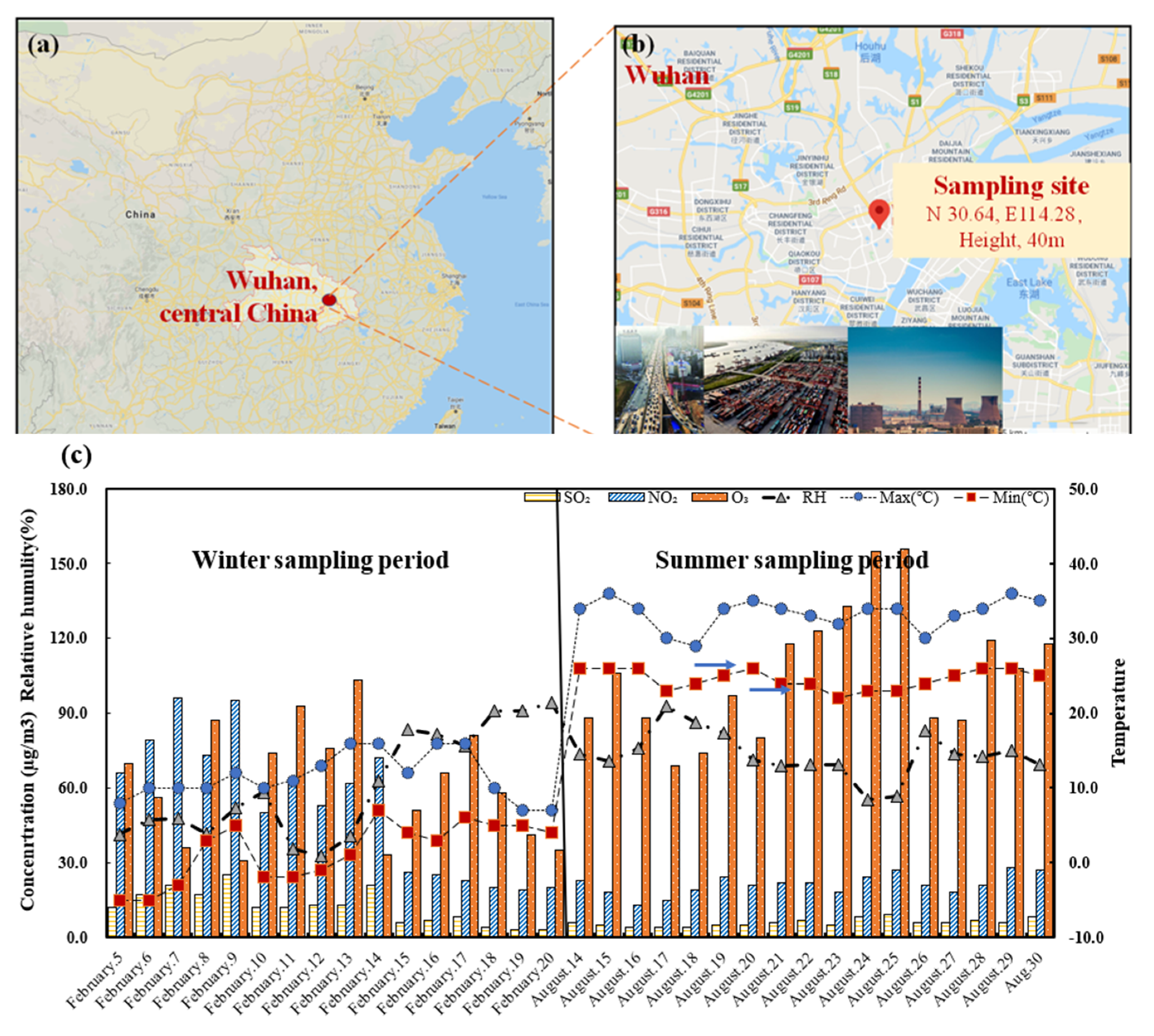
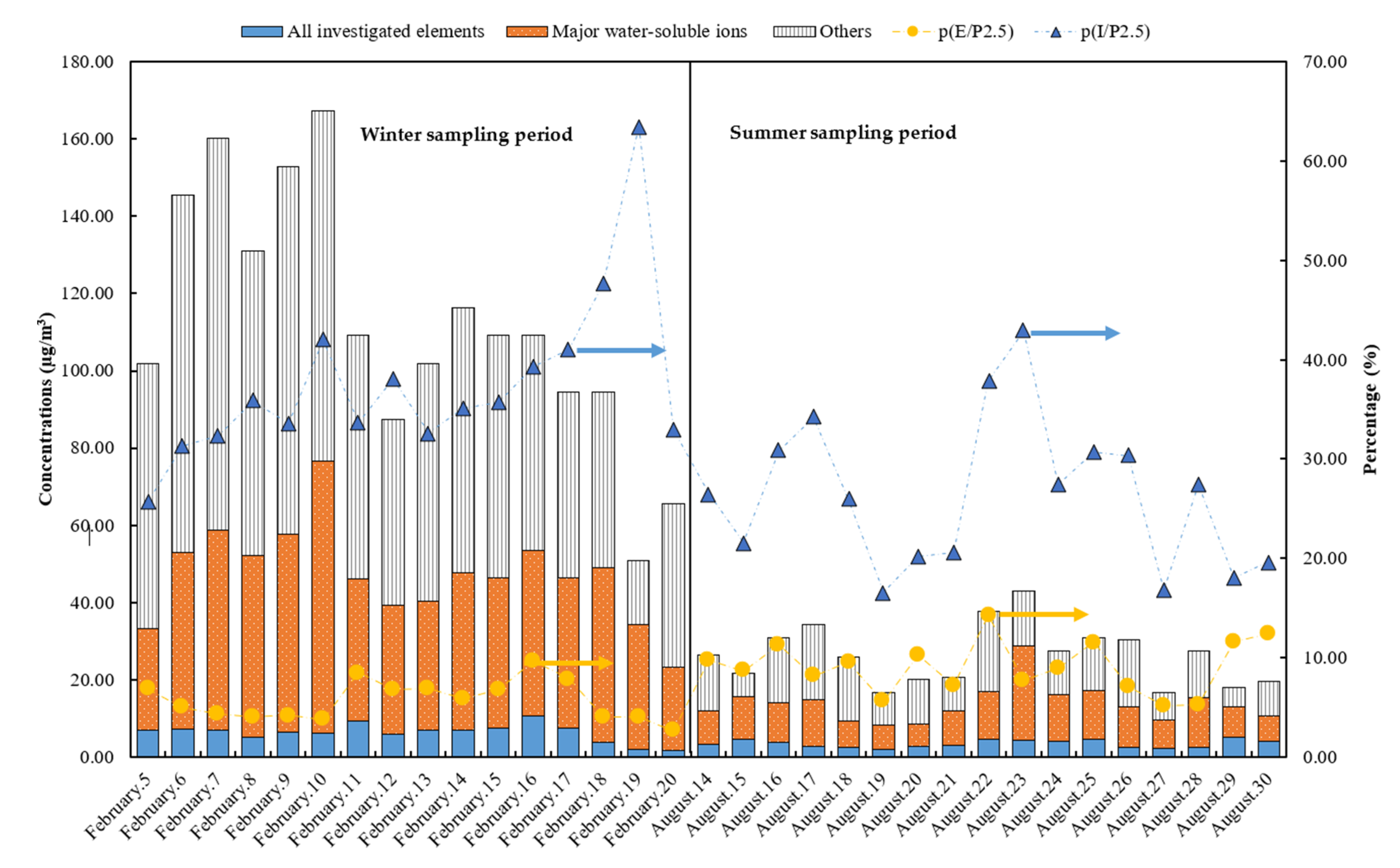
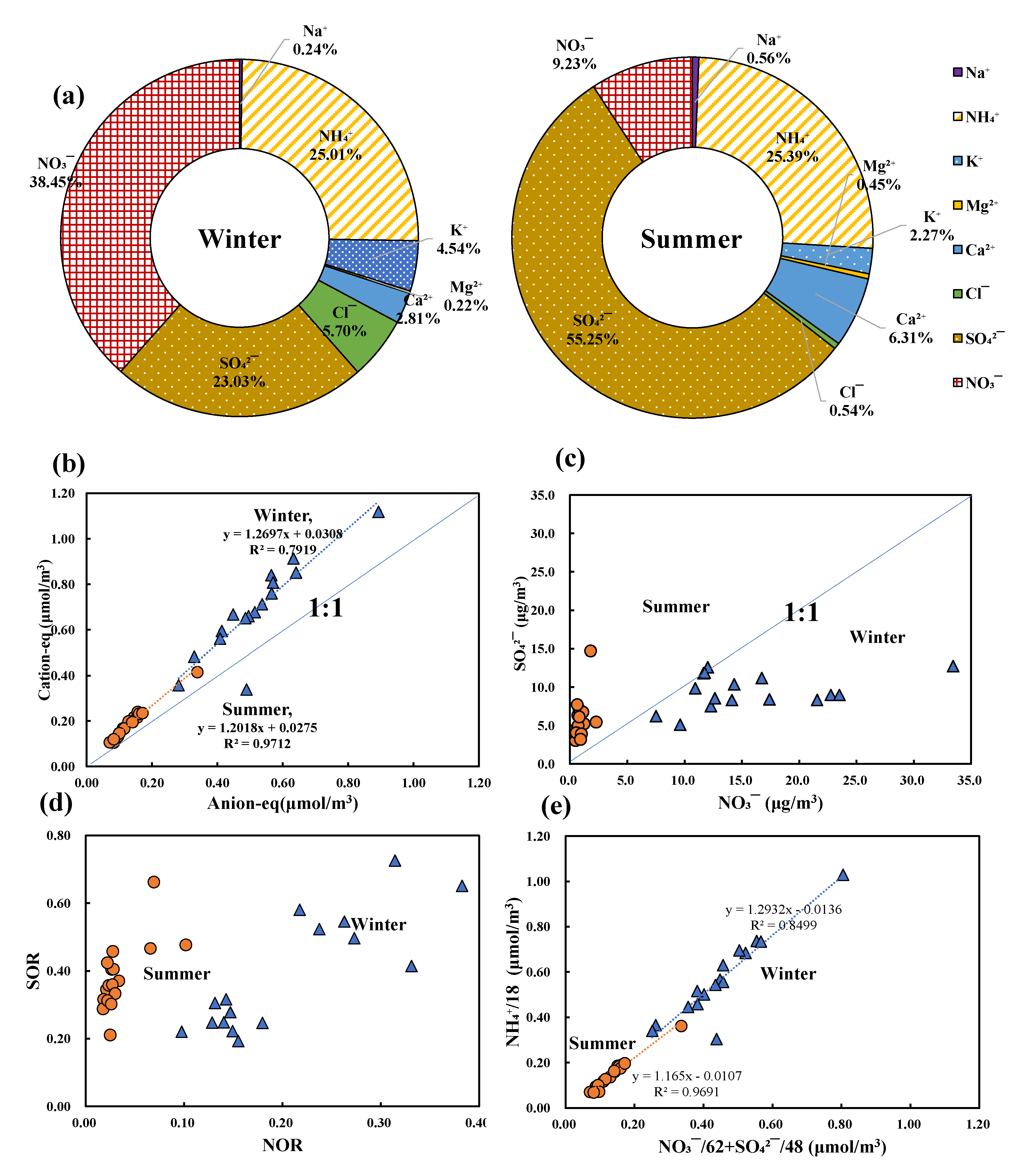
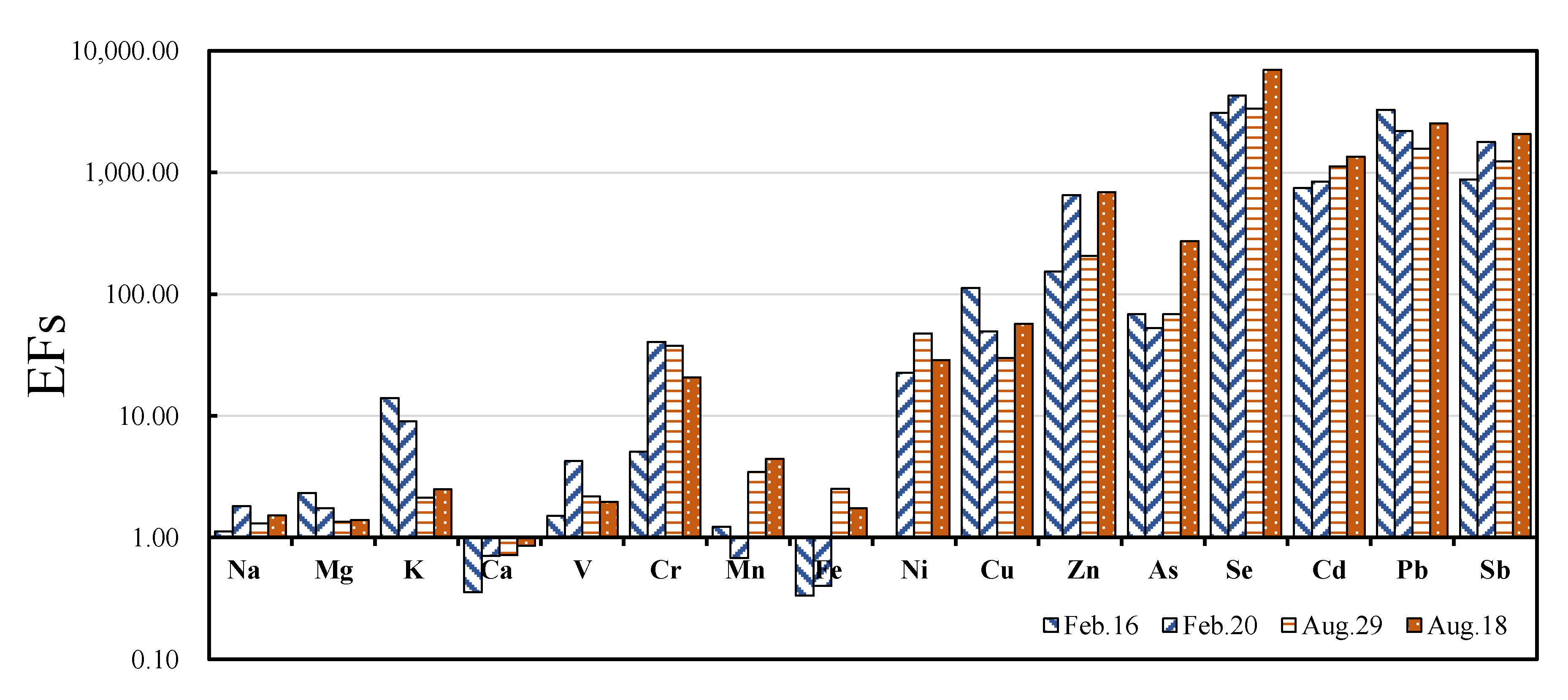
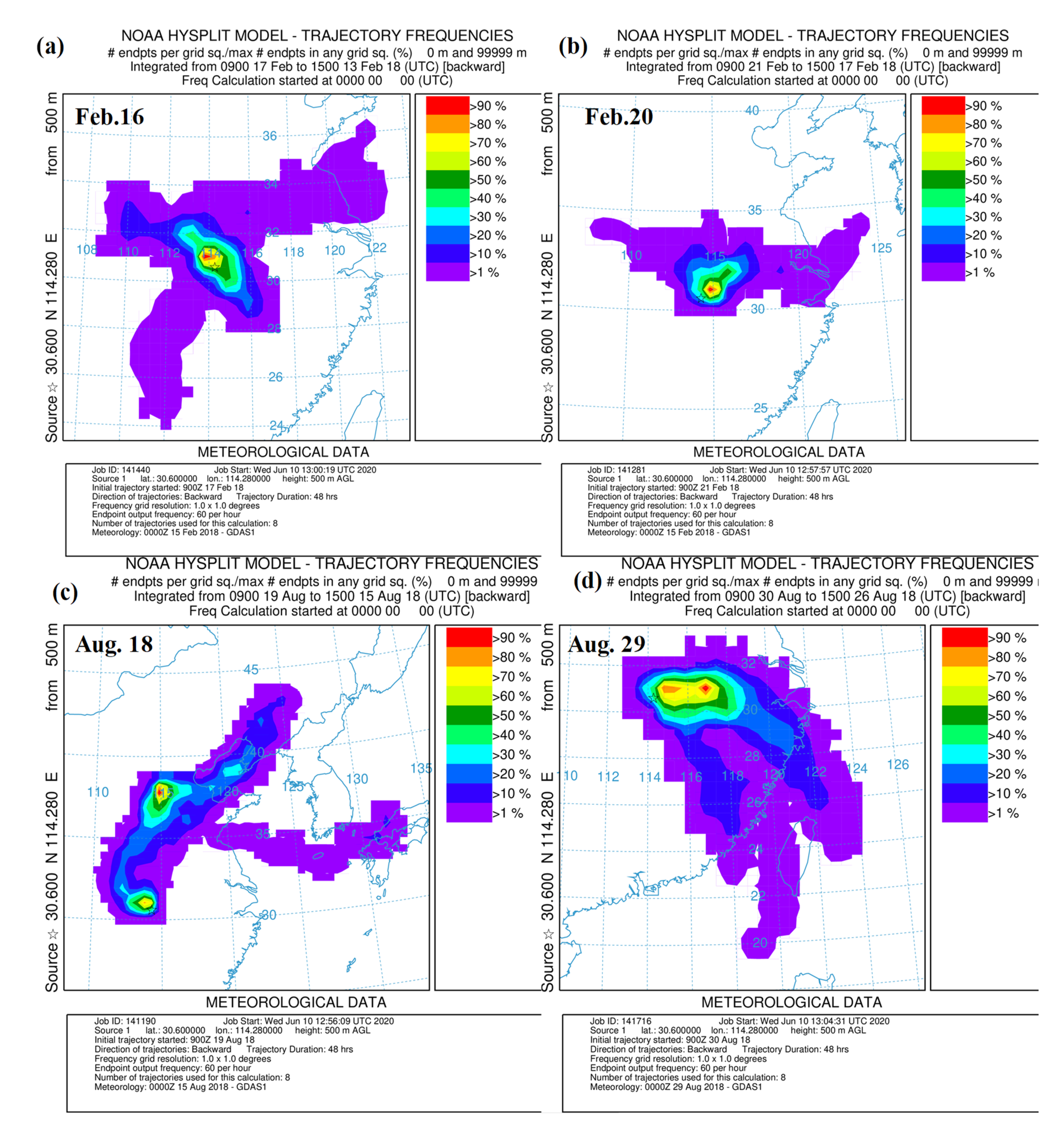
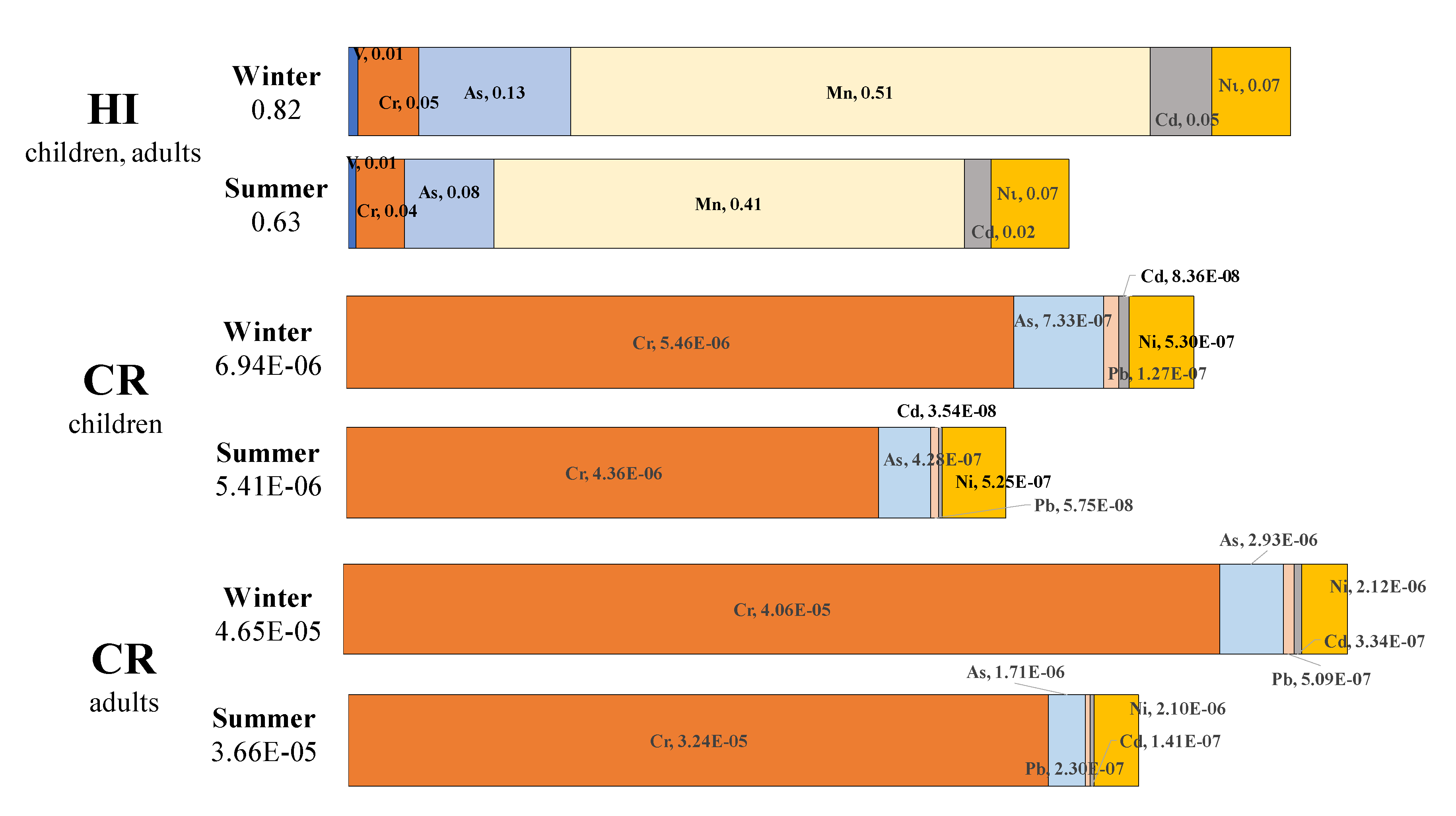
| Winter | Summer | |||||||||
|---|---|---|---|---|---|---|---|---|---|---|
| Average | Max | Min | Median | SD | Average | Max | Min | Median | SD | |
| ng/m3 | ng/m3 | ng/m3 | ng/m3 | ng/m3 | ng/m3 | ng/m3 | ng/m3 | |||
| Na | 9.80E + 02 | 9.80E + 02 | 1.69E + 02 | 6.11E + 02 | 2.23E + 02 | 3.27E + 02 | 4.93E + 02 | 2.10E + 02 | 3.22E + 02 | 7.68E + 01 |
| Mg | 4.77E + 02 | 9.27E + 02 | 9.70E + 01 | 5.22E + 02 | 2.10E + 02 | 2.19E + 02 | 3.36E + 02 | 1.42E + 02 | 2.26E + 02 | 6.45E + 01 |
| Al | 1.35E + 03 | 2.87E + 03 | 3.14E + 02 | 1.40E + 03 | 6.10E + 02 | 9.14E + 02 | 1.68E + 03 | 4.19E + 02 | 9.02E + 02 | 6.45E + 01 |
| K | 2.27E + 03 | 6.69E + 03 | 6.74E + 02 | 1.72E + 03 | 1.66E + 03 | 6.29E + 02 | 1.12E + 03 | 4.12E + 02 | 5.88E + 02 | 2.04E + 02 |
| Ca | 2.98E + 02 | 5.59E + 02 | 7.01E + 01 | 2.84E + 02 | 1.64E + 02 | 2.11E + 02 | 3.40E + 02 | 1.08E + 02 | 2.13E + 02 | 7.18E + 01 |
| V | 3.29E + 00 | 5.16E + 00 | 1.57E + 00 | 3.04E + 00 | 1.03E + 00 | 2.75E + 00 | 6.07E + 00 | 1.15E + 00 | 2.66E + 00 | 1.24E + 00 |
| Cr | 2.33E + 01 | 8.35E + 01 | 7.61E + 00 | 1.60E + 01 | 2.14E + 01 | 1.86E + 01 | 5.95E + 01 | 3.16E + 00 | 1.36E + 01 | 1.64E + 01 |
| Mn | 3.33E + 01 | 6.00E + 01 | 2.03E + 00 | 3.37E + 01 | 2.07E + 01 | 2.71E + 01 | 4.14E + 01 | 1.82E + 01 | 2.45E + 01 | 8.61E + 00 |
| Fe | 8.89E + 02 | 1.93E + 03 | 6.02E + 01 | 9.84E + 02 | 6.50E + 02 | 8.05E + 02 | 1.54E + 03 | 3.53E + 02 | 7.50E + 02 | 3.79E + 02 |
| Ni | 1.51E + 01 | 1.05E + 02 | 0.00E + 00 | 5.21E + 00 | 2.80E + 01 | 1.49E + 01 | 3.85E + 01 | 0.00E + 00 | 1.06E + 01 | 1.23E + 01 |
| Cu | 3.07E + 01 | 6.53E + 01 | 4.35E + 00 | 2.81E + 01 | 1.76E + 01 | 8.31E + 00 | 1.70E + 01 | 2.23E + 00 | 7.88E + 00 | 4.73E + 00 |
| Zn | 2.82E + 02 | 4.67E + 02 | 1.69E + 02 | 2.69E + 02 | 7.24E + 01 | 2.31E + 02 | 3.36E + 02 | 1.12E + 02 | 2.17E + 02 | 6.23E + 01 |
| As | 8.74E + 00 | 2.12E + 01 | 8.97E − 01 | 7.31E + 00 | 5.68E + 00 | 5.10E + 00 | 1.29E + 01 | 1.58E + 00 | 4.38E + 00 | 3.07E + 00 |
| Se | 5.92E + 00 | 1.19E + 01 | 1.49E + 00 | 6.08E + 00 | 3.00E + 00 | 4.60E + 00 | 8.97E + 00 | 2.13E + 00 | 4.52E + 00 | 1.58E + 00 |
| Cd | 2.38E + 00 | 5.60E + 00 | 2.92E − 01 | 2.06E + 00 | 1.52E + 00 | 1.01E + 00 | 1.76E + 00 | 5.31E − 01 | 8.71E − 01 | 4.13E − 01 |
| Pb | 8.14E + 01 | 1.33E + 02 | 1.27E + 01 | 9.27E + 01 | 3.65E + 01 | 3.68E + 01 | 8.43E + 01 | 1.44E + 01 | 2.89E + 01 | 1.86E + 01 |
| Sb | 4.22E + 00 | 6.77E + 00 | 1.25E + 00 | 4.10E + 00 | 1.73E + 00 | 3.55E + 00 | 6.29E + 00 | 1.28E + 00 | 3.84E + 00 | 1.16E + 00 |
| 17 elements | 6.32E + 03 | 1.05E + 04 | 1.73E + 03 | 6.87E + 03 | 2.28E + 00 | 3.46E + 03 | 5.07E + 03 | 2.08E + 03 | 3.19E + 03 | 9.84E − 01 |
© 2020 by the authors. Licensee MDPI, Basel, Switzerland. This article is an open access article distributed under the terms and conditions of the Creative Commons Attribution (CC BY) license (http://creativecommons.org/licenses/by/4.0/).
Share and Cite
Wang, W.; Zhang, W.; Dong, S.; Yonemachi, S.; Lu, S.; Wang, Q. Characterization, Pollution Sources, and Health Risk of Ionic and Elemental Constituents in PM2.5 of Wuhan, Central China. Atmosphere 2020, 11, 760. https://doi.org/10.3390/atmos11070760
Wang W, Zhang W, Dong S, Yonemachi S, Lu S, Wang Q. Characterization, Pollution Sources, and Health Risk of Ionic and Elemental Constituents in PM2.5 of Wuhan, Central China. Atmosphere. 2020; 11(7):760. https://doi.org/10.3390/atmos11070760
Chicago/Turabian StyleWang, Weiqian, Weilin Zhang, Shiyang Dong, Shinichi Yonemachi, Senlin Lu, and Qingyue Wang. 2020. "Characterization, Pollution Sources, and Health Risk of Ionic and Elemental Constituents in PM2.5 of Wuhan, Central China" Atmosphere 11, no. 7: 760. https://doi.org/10.3390/atmos11070760
APA StyleWang, W., Zhang, W., Dong, S., Yonemachi, S., Lu, S., & Wang, Q. (2020). Characterization, Pollution Sources, and Health Risk of Ionic and Elemental Constituents in PM2.5 of Wuhan, Central China. Atmosphere, 11(7), 760. https://doi.org/10.3390/atmos11070760








